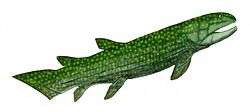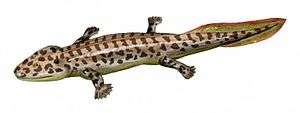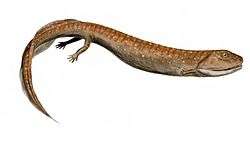Letognathus
Letognathus is a genus of rhizodont tetrapodomorph that lived during the Carboniferous period.[1] Its remains come from the Blue Beach Member of the Horton Bluff Formation, near Hantsport, Nova Scotia. Like most rhizodonts, it was of relatively large size, had a large recurved fang at the symphysis of the lower jaw, and a row of three coronoid fanks along the length of the jaw in addition to its marginal dentition. Letognathus is important for rhizodont systematics because it retains a number of primitive features, such as ossified Meckel's cartilage, are not found in the genera Rhizodus and Strepsodus.
| Letognathus Temporal range: Early Carboniferous | |
|---|---|
| Scientific classification | |
| Kingdom: | |
| Phylum: | |
| Class: | |
| Family: | |
| Genus: | Letognathus |
| Species: | L. hardingi |
| Binomial name | |
| Letognathus hardingi | |
Taxonomic History
The members of the Rhizodontida have nearly all had complex taxonomic histories[2] due to earlier use of the genus Strepsodus as a wastebasket taxon. The taxon was originally assigned to the genus Rhizodus by John William Dawson and later to Strepsodus by Arthur Smith Woodward. A new genus was erected for the Horton Bluff material based on a number of differences from either Strepsodus or Rhizodus.
References
- Brazeau, M.D. 2005. A new genus of rhizodontid (Sarcopterygii, Tetrapodomorpha) from the Lower Carboniferous Horton Bluff Formation of Nova Scotia, and the evolution of the lower jaws in this group. Canadian Journal of Earth Sciences 42:1481–1499
- Jeffery, J.E. 2006. The Carboniferous fish genera Strepsodus and Archichthys (Rhizodontida: Sarcopterygii): clarifying 150 years of confusion. Palaeontology 49: 113-132






